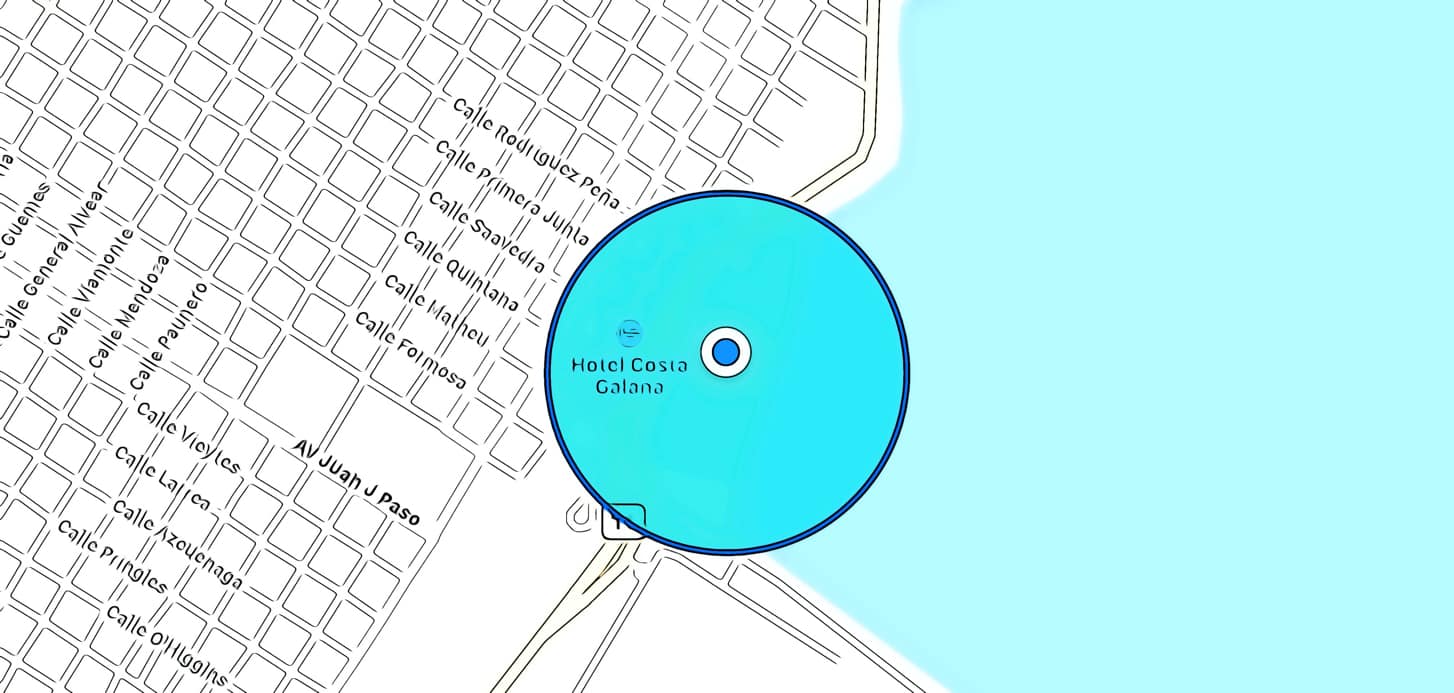Ya es hora de que volvamos a echar un vistazo al Geofencing. La tecnología ha sido una poderosa forma de llegar a los consumidores en el mejor momento y en los lugares adecuados. Pero, ¿cómo han cambiado las capacidades y cómo pueden los profesionales del marketing utilizar mejor la tecnología a medida que avanzamos en la nueva década?
¿Qué es la geovalla?
El marketing de geovallas es una forma de marketing basado en la localización en la que se coloca un límite geográfico alrededor de un punto de interés. Cuando un dispositivo móvil entra en esta zona, la geocerca puede desencadenar varios eventos diferentes. Estos desencadenantes suelen ser la entrega de algún tipo de publicidad. Históricamente, esto se ha hecho a través del marketing por SMS, pero cada vez más este proceso se ha desarrollado para incluir las notificaciones push e incluso encajar perfectamente en la pila de publicidad programática.
A definition of geofencing in 2023
El geofencing es una tecnología que existe desde hace tiempo. Siempre está en desarrollo, y los profesionales del marketing están encontrando nuevas formas intuitivas de utilizarla eficazmente.
El geofencing es útil para la publicidad instantánea basada en la localización. Pero su uso puede ir más allá de este simple marketing momentáneo. El geofencing puede utilizarse para identificar y construir grandes audiencias direccionables a lo largo del tiempo. Como veremos, incluso puede tener un papel en el retargeting, la atribución y otros conocimientos basados en la ubicación.
¿Cómo funciona el geofencing?
La geofencing consiste principalmente en los siguientes pasos:
- Identificar un radio geográfico alrededor de un lugar del mundo real.
- Establezca una geocerca (barrera virtual) alrededor del lugar.
- Cuando un dispositivo entra o sale, se puede activar un evento.
¿Cuáles son las limitaciones del geofencing en el marketing y la publicidad? (Lo que no se puede hacer)
No toda la tecnología de geovallas es perfecta. A veces un dispositivo se registra dentro de una geocerca cuando, en realidad, no lo está. Otras veces la geocerca se establece alrededor de una tienda, pero en ciudades concurridas y otros lugares difíciles de medir, a veces esto significa que los dispositivos se atribuyen falsamente a la ubicación física.
Estas cuestiones hacen que la geolocalización tenga que ser precisa. Para proporcionar el máximo valor a los consumidores, los anuncios tienen que ser relevantes. Enviar directamente un mensaje a todos los que pasan por delante de una tienda no es una opción viable.
En Tamoco, estamos obsesionados con la precisión. Queremos que nuestros clientes estén seguros de que un dispositivo está siendo localizado porque realmente ha visitado una ubicación. Por eso construimos una solución que entiende más que un solo punto de datos cuando calcula si un dispositivo está dentro de un PDI o una geocerca.
La geocerca también tiene problemas de escalabilidad. El hecho de estar tan orientado y en el momento significa que la audiencia a la que se puede dirigir una campaña de geofencing puede ser bastante pequeña.
Una campaña de geofencing puede funcionar en los establecimientos de McDonald's, por ejemplo, pero esto se debe a que hay un número importante de ellos. Cuando se trata de campañas más pequeñas, la confianza en su propia audiencia podría no ser suficiente.
Por esta razón, podría ser mejor dirigirse a un tipo de consumidor o construir un segmento a lo largo del tiempo que consista en visitas.
Lo que se puede hacer con el geofencing (mejor)
El simple empuje del geofencing ya no es tan potente como antes. Con una mayor precisión y un enfoque ligeramente diferente, todavía se puede utilizar la localización para conseguir resultados convincentes. Veamos cómo.
Marketing y publicidad
Dirigido a
El geofencing se ha utilizado tradicionalmente para dirigirse a los dispositivos cuando entran en una geocerca. La marca colocaría un radio alrededor de sus tiendas, por ejemplo. Cuando un dispositivo que utiliza su aplicación entra en esas zonas, se le envía un mensaje que le anima a visitar el establecimiento.
Como ya hemos mencionado, esto no siempre es preciso en la práctica. Es probable que las geocercas más grandes incluyan dispositivos que no están cerca o que no están dentro de una tienda de la competencia. Esto puede hacer que el mensaje publicitario sea irrelevante.
Otro problema potencial de la segmentación por geocercas es la falta de escala de la audiencia. Si utiliza la tecnología con su propia aplicación, se necesita una gran audiencia para enviar mensajes a la escala necesaria para cambiar la aguja.
Unos mejores datos geográficos significan que se puede observar el dispositivo a través de cómo se comporta a lo largo del tiempo. La segmentación en el momento es eficaz, pero la creación de un perfil detallado y su uso para crear segmentos proporciona un mayor alcance y una mayor precisión.
El uso de geolocalización para la geolocalización significa que puede dirigirse a más dispositivos fuera de su público de origen. Puede leer más sobre geolocalización para la segmentación aquí.
Geocercas de medición
Otra ventaja de utilizar la orientación basada en la ubicación es la posibilidad de medir el efecto de las campañas de marketing basadas en la ubicación o de geofencing. Por ejemplo, si te diriges a los dispositivos en función de su proximidad a una ubicación, ¿cómo sabes si realizaron el objetivo deseado, sobre todo si esto es en el mundo real?
El uso de geolocalización para la segmentación significa que la misma tecnología puede utilizarse para confirmar si los dispositivos visitan un local comercial después de recibir cualquier tipo de publicidad. Una mayor precisión significa que se puede tener la certeza de que se trata de una visita a un local, en lugar de una simple persona que pasea por las inmediaciones.
Por ello, el uso de geocercas o polígonos de PDI precisos puede ayudarle a atribuir sus campañas publicitarias. Esto se extiende más allá de sus campañas de geofencing para incluir su publicidad digital, campañas fuera de casa, y mucho más.
El futuro del marketing de geofencing
Geofencing marketing v location targeting
El geofencing en marketing puede seguir siendo una forma eficaz de llegar a los consumidores en el mejor momento posible. Pero para las marcas que quieren identificar grupos más grandes de consumidores relevantes, no siempre es la mejor solución.
En cambio, los segmentos de audiencia basados en la ubicación ofrecen lo mejor de ambos mundos. Estos segmentos siguen basándose en ubicaciones del mundo real y, por lo tanto, conllevan una intención del mundo real. Son escalables porque estos segmentos pueden construirse durante un período de tiempo más largo.
Otra ventaja de este tipo de campañas es que puede activar segmentos directamente en sus canales de marketing.
Esto significa que no es necesario depender del push en las aplicaciones. Puede utilizar toda la pila de marketing programático para dirigirse a los usuarios dondequiera que estén.
Sobre los segmentos de ubicación de Tamoco
Nuestros segmentos proporcionan una mayor escala para los vendedores que buscan hacer una mejor orientación de localización. Nuestros datos de primera mano se centran en la precisión, lo que permite a los profesionales del marketing realizar campañas más precisas basadas en la geografía.
Active hoy mismo los segmentos basados en la localización.
James es el jefe de marketing de Tamoco

